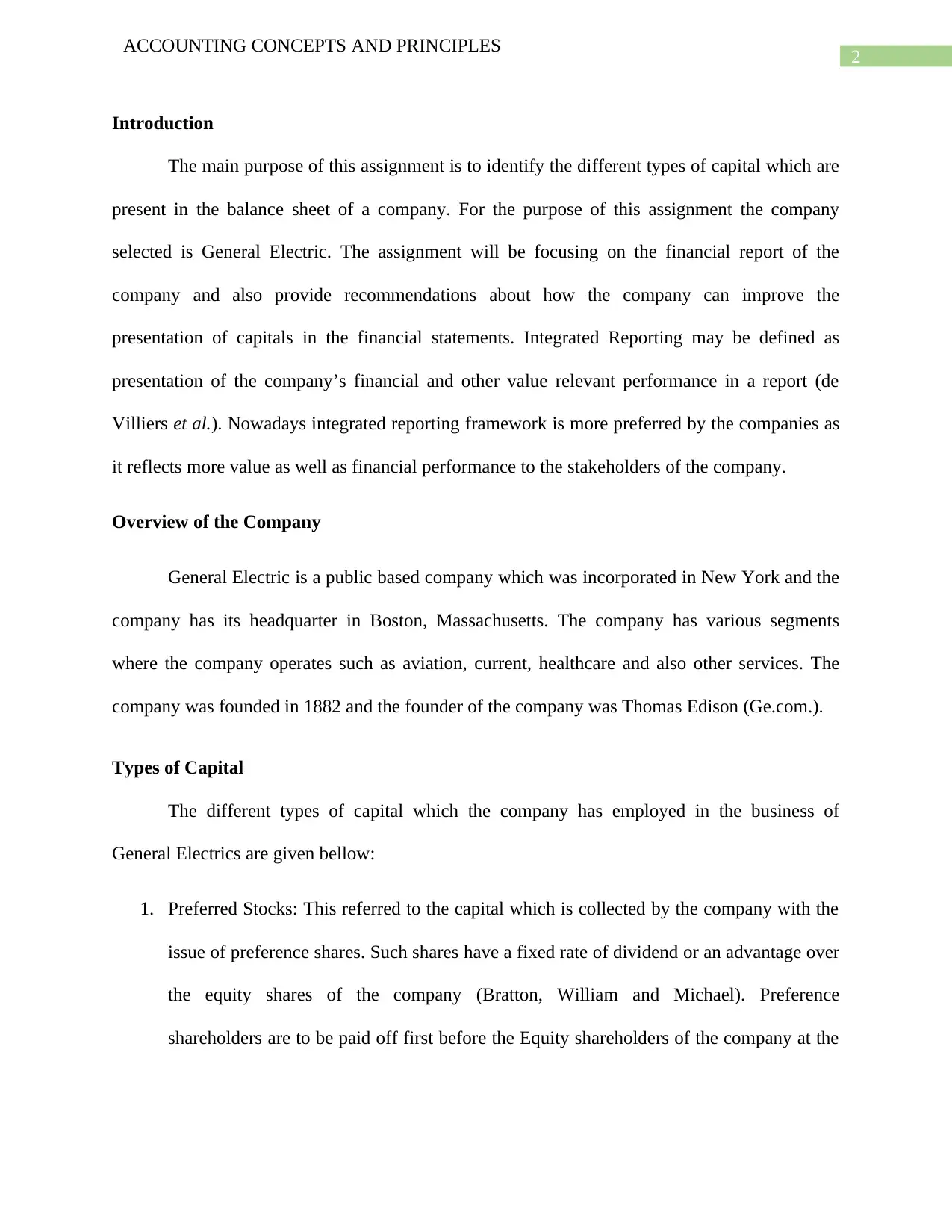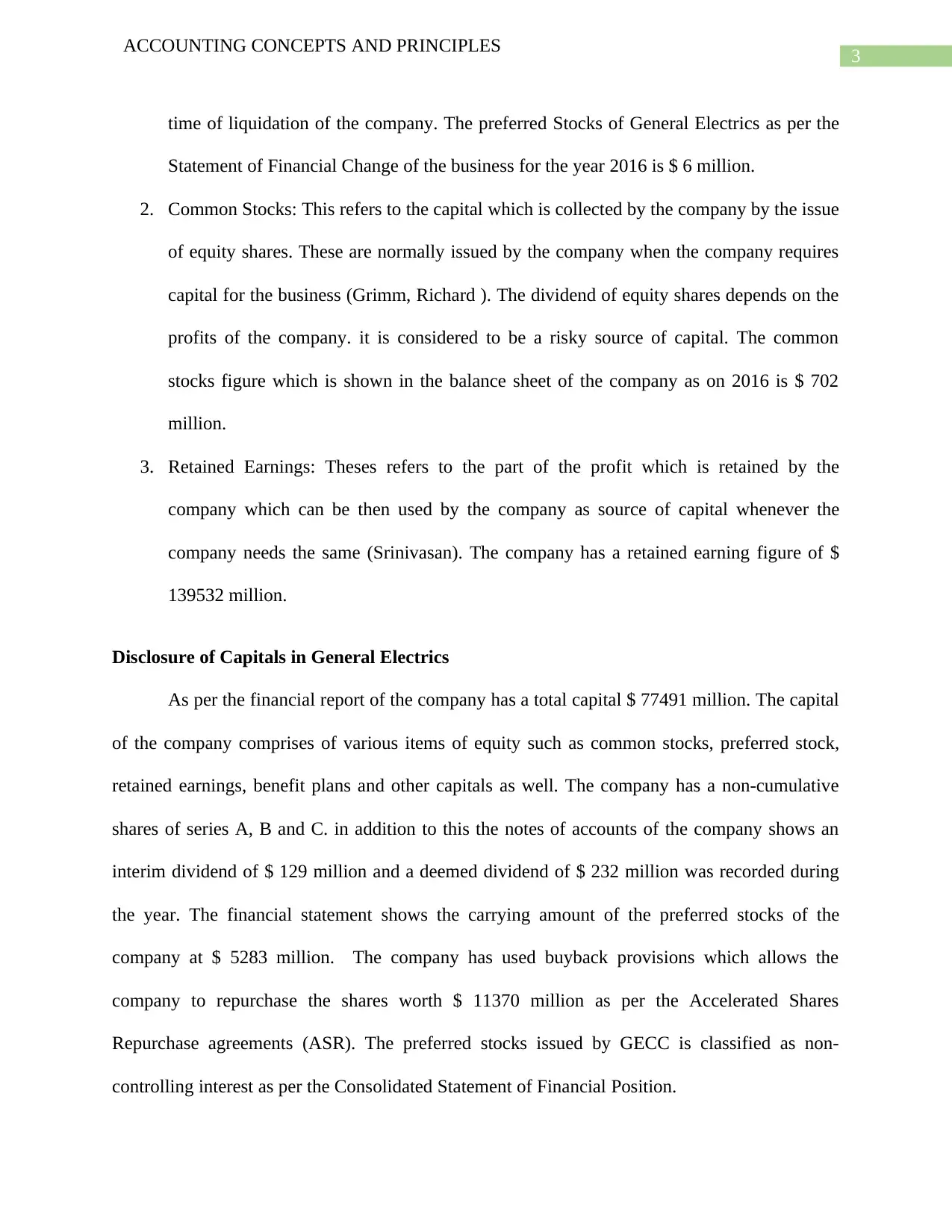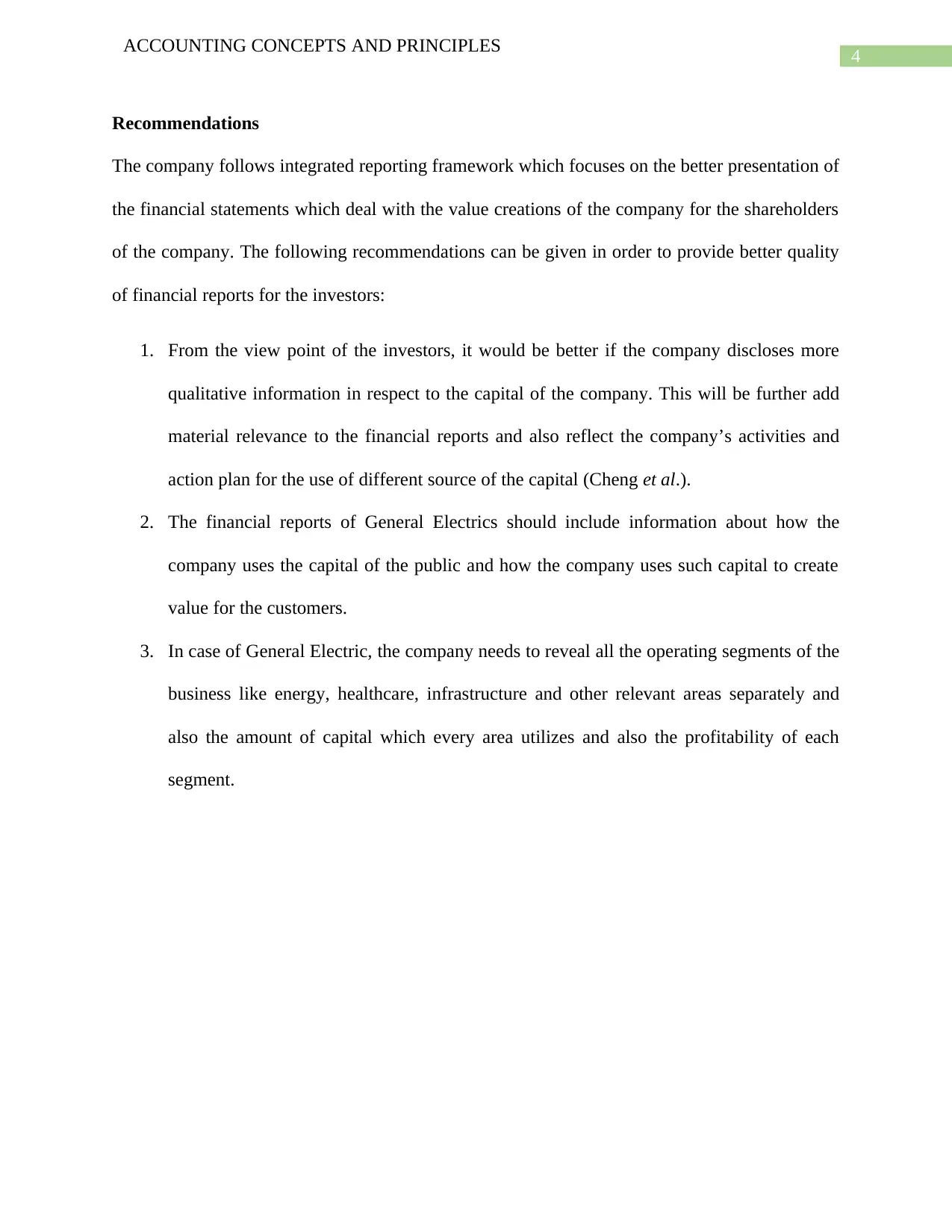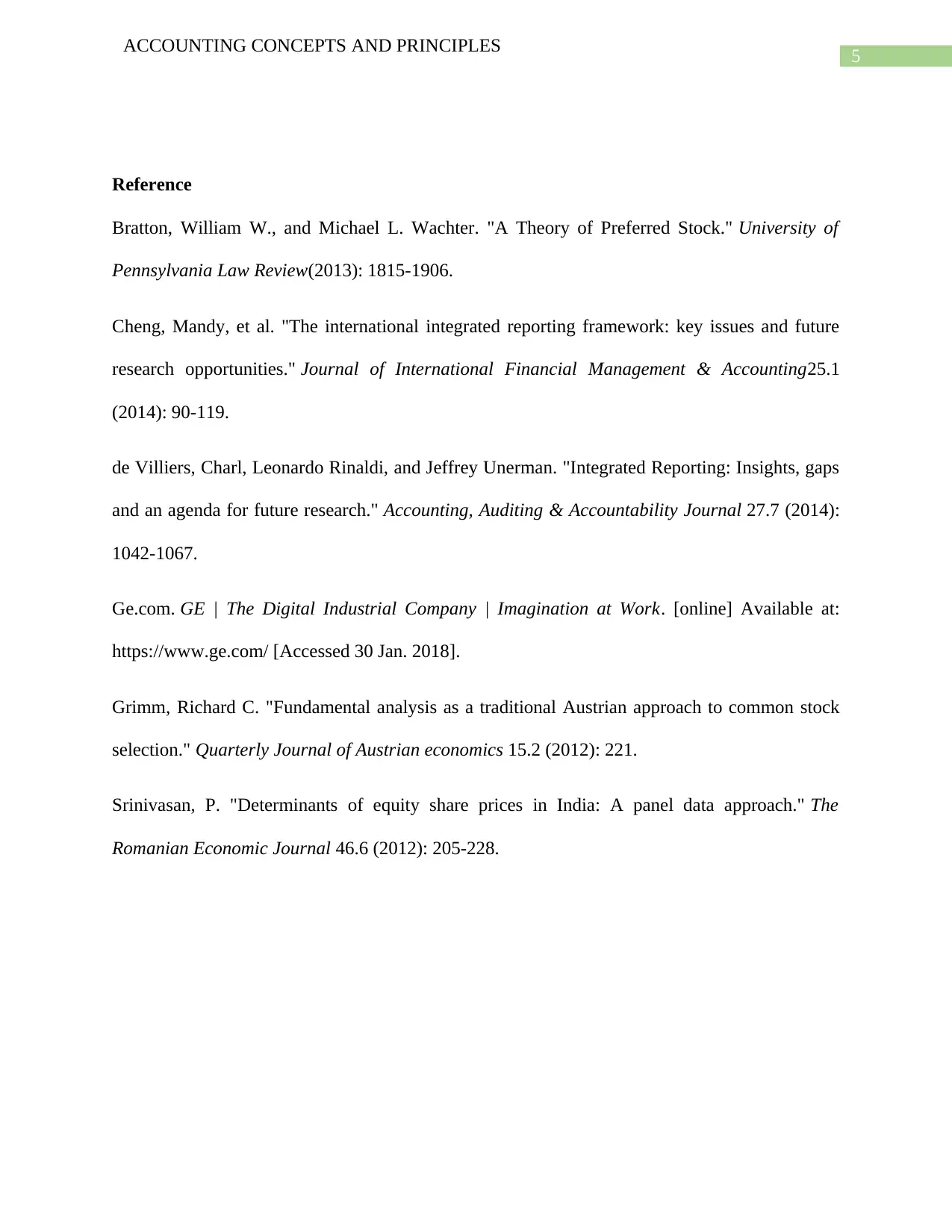Analyzing Capital Structure: Accounting Concepts in General Electric
VerifiedAdded on 2023/06/15
|6
|1094
|261
Report
AI Summary
This assignment identifies and analyzes the different types of capital employed by General Electric, focusing on preferred stocks, common stocks, and retained earnings as disclosed in the company's financial reports. It examines the company's disclosure of capital, referencing the financial report of 2016, and includes analysis of non-cumulative shares, interim dividends, and share repurchase agreements. Furthermore, the report offers recommendations for improving the quality of financial reporting, such as providing more qualitative information about capital usage, disclosing how capital creates value for customers, and separately revealing the capital utilization and profitability of different operating segments within General Electric. This analysis aims to provide investors with a clearer understanding of General Electric's financial strategies and capital management.

Running head: ACCOUNTING CONCEPTS AND PRINCIPLES
ACCOUNTING CONCEPTS AND PRINCIPLES
Name of the Student:
Name of the University:
Author’s Note:
ACCOUNTING CONCEPTS AND PRINCIPLES
Name of the Student:
Name of the University:
Author’s Note:
Paraphrase This Document
Need a fresh take? Get an instant paraphrase of this document with our AI Paraphraser

1
ACCOUNTING CONCEPTS AND PRINCIPLES
Table of Contents
Introduction......................................................................................................................................2
Types of Capital...............................................................................................................................2
Disclosure of Capitals in General Electrics.....................................................................................3
Recommendations............................................................................................................................4
Reference.........................................................................................................................................5
ACCOUNTING CONCEPTS AND PRINCIPLES
Table of Contents
Introduction......................................................................................................................................2
Types of Capital...............................................................................................................................2
Disclosure of Capitals in General Electrics.....................................................................................3
Recommendations............................................................................................................................4
Reference.........................................................................................................................................5

2
ACCOUNTING CONCEPTS AND PRINCIPLES
Introduction
The main purpose of this assignment is to identify the different types of capital which are
present in the balance sheet of a company. For the purpose of this assignment the company
selected is General Electric. The assignment will be focusing on the financial report of the
company and also provide recommendations about how the company can improve the
presentation of capitals in the financial statements. Integrated Reporting may be defined as
presentation of the company’s financial and other value relevant performance in a report (de
Villiers et al.). Nowadays integrated reporting framework is more preferred by the companies as
it reflects more value as well as financial performance to the stakeholders of the company.
Overview of the Company
General Electric is a public based company which was incorporated in New York and the
company has its headquarter in Boston, Massachusetts. The company has various segments
where the company operates such as aviation, current, healthcare and also other services. The
company was founded in 1882 and the founder of the company was Thomas Edison (Ge.com.).
Types of Capital
The different types of capital which the company has employed in the business of
General Electrics are given bellow:
1. Preferred Stocks: This referred to the capital which is collected by the company with the
issue of preference shares. Such shares have a fixed rate of dividend or an advantage over
the equity shares of the company (Bratton, William and Michael). Preference
shareholders are to be paid off first before the Equity shareholders of the company at the
ACCOUNTING CONCEPTS AND PRINCIPLES
Introduction
The main purpose of this assignment is to identify the different types of capital which are
present in the balance sheet of a company. For the purpose of this assignment the company
selected is General Electric. The assignment will be focusing on the financial report of the
company and also provide recommendations about how the company can improve the
presentation of capitals in the financial statements. Integrated Reporting may be defined as
presentation of the company’s financial and other value relevant performance in a report (de
Villiers et al.). Nowadays integrated reporting framework is more preferred by the companies as
it reflects more value as well as financial performance to the stakeholders of the company.
Overview of the Company
General Electric is a public based company which was incorporated in New York and the
company has its headquarter in Boston, Massachusetts. The company has various segments
where the company operates such as aviation, current, healthcare and also other services. The
company was founded in 1882 and the founder of the company was Thomas Edison (Ge.com.).
Types of Capital
The different types of capital which the company has employed in the business of
General Electrics are given bellow:
1. Preferred Stocks: This referred to the capital which is collected by the company with the
issue of preference shares. Such shares have a fixed rate of dividend or an advantage over
the equity shares of the company (Bratton, William and Michael). Preference
shareholders are to be paid off first before the Equity shareholders of the company at the
⊘ This is a preview!⊘
Do you want full access?
Subscribe today to unlock all pages.

Trusted by 1+ million students worldwide

3
ACCOUNTING CONCEPTS AND PRINCIPLES
time of liquidation of the company. The preferred Stocks of General Electrics as per the
Statement of Financial Change of the business for the year 2016 is $ 6 million.
2. Common Stocks: This refers to the capital which is collected by the company by the issue
of equity shares. These are normally issued by the company when the company requires
capital for the business (Grimm, Richard ). The dividend of equity shares depends on the
profits of the company. it is considered to be a risky source of capital. The common
stocks figure which is shown in the balance sheet of the company as on 2016 is $ 702
million.
3. Retained Earnings: Theses refers to the part of the profit which is retained by the
company which can be then used by the company as source of capital whenever the
company needs the same (Srinivasan). The company has a retained earning figure of $
139532 million.
Disclosure of Capitals in General Electrics
As per the financial report of the company has a total capital $ 77491 million. The capital
of the company comprises of various items of equity such as common stocks, preferred stock,
retained earnings, benefit plans and other capitals as well. The company has a non-cumulative
shares of series A, B and C. in addition to this the notes of accounts of the company shows an
interim dividend of $ 129 million and a deemed dividend of $ 232 million was recorded during
the year. The financial statement shows the carrying amount of the preferred stocks of the
company at $ 5283 million. The company has used buyback provisions which allows the
company to repurchase the shares worth $ 11370 million as per the Accelerated Shares
Repurchase agreements (ASR). The preferred stocks issued by GECC is classified as non-
controlling interest as per the Consolidated Statement of Financial Position.
ACCOUNTING CONCEPTS AND PRINCIPLES
time of liquidation of the company. The preferred Stocks of General Electrics as per the
Statement of Financial Change of the business for the year 2016 is $ 6 million.
2. Common Stocks: This refers to the capital which is collected by the company by the issue
of equity shares. These are normally issued by the company when the company requires
capital for the business (Grimm, Richard ). The dividend of equity shares depends on the
profits of the company. it is considered to be a risky source of capital. The common
stocks figure which is shown in the balance sheet of the company as on 2016 is $ 702
million.
3. Retained Earnings: Theses refers to the part of the profit which is retained by the
company which can be then used by the company as source of capital whenever the
company needs the same (Srinivasan). The company has a retained earning figure of $
139532 million.
Disclosure of Capitals in General Electrics
As per the financial report of the company has a total capital $ 77491 million. The capital
of the company comprises of various items of equity such as common stocks, preferred stock,
retained earnings, benefit plans and other capitals as well. The company has a non-cumulative
shares of series A, B and C. in addition to this the notes of accounts of the company shows an
interim dividend of $ 129 million and a deemed dividend of $ 232 million was recorded during
the year. The financial statement shows the carrying amount of the preferred stocks of the
company at $ 5283 million. The company has used buyback provisions which allows the
company to repurchase the shares worth $ 11370 million as per the Accelerated Shares
Repurchase agreements (ASR). The preferred stocks issued by GECC is classified as non-
controlling interest as per the Consolidated Statement of Financial Position.
Paraphrase This Document
Need a fresh take? Get an instant paraphrase of this document with our AI Paraphraser

4
ACCOUNTING CONCEPTS AND PRINCIPLES
Recommendations
The company follows integrated reporting framework which focuses on the better presentation of
the financial statements which deal with the value creations of the company for the shareholders
of the company. The following recommendations can be given in order to provide better quality
of financial reports for the investors:
1. From the view point of the investors, it would be better if the company discloses more
qualitative information in respect to the capital of the company. This will be further add
material relevance to the financial reports and also reflect the company’s activities and
action plan for the use of different source of the capital (Cheng et al.).
2. The financial reports of General Electrics should include information about how the
company uses the capital of the public and how the company uses such capital to create
value for the customers.
3. In case of General Electric, the company needs to reveal all the operating segments of the
business like energy, healthcare, infrastructure and other relevant areas separately and
also the amount of capital which every area utilizes and also the profitability of each
segment.
ACCOUNTING CONCEPTS AND PRINCIPLES
Recommendations
The company follows integrated reporting framework which focuses on the better presentation of
the financial statements which deal with the value creations of the company for the shareholders
of the company. The following recommendations can be given in order to provide better quality
of financial reports for the investors:
1. From the view point of the investors, it would be better if the company discloses more
qualitative information in respect to the capital of the company. This will be further add
material relevance to the financial reports and also reflect the company’s activities and
action plan for the use of different source of the capital (Cheng et al.).
2. The financial reports of General Electrics should include information about how the
company uses the capital of the public and how the company uses such capital to create
value for the customers.
3. In case of General Electric, the company needs to reveal all the operating segments of the
business like energy, healthcare, infrastructure and other relevant areas separately and
also the amount of capital which every area utilizes and also the profitability of each
segment.

5
ACCOUNTING CONCEPTS AND PRINCIPLES
Reference
Bratton, William W., and Michael L. Wachter. "A Theory of Preferred Stock." University of
Pennsylvania Law Review(2013): 1815-1906.
Cheng, Mandy, et al. "The international integrated reporting framework: key issues and future
research opportunities." Journal of International Financial Management & Accounting25.1
(2014): 90-119.
de Villiers, Charl, Leonardo Rinaldi, and Jeffrey Unerman. "Integrated Reporting: Insights, gaps
and an agenda for future research." Accounting, Auditing & Accountability Journal 27.7 (2014):
1042-1067.
Ge.com. GE | The Digital Industrial Company | Imagination at Work. [online] Available at:
https://www.ge.com/ [Accessed 30 Jan. 2018].
Grimm, Richard C. "Fundamental analysis as a traditional Austrian approach to common stock
selection." Quarterly Journal of Austrian economics 15.2 (2012): 221.
Srinivasan, P. "Determinants of equity share prices in India: A panel data approach." The
Romanian Economic Journal 46.6 (2012): 205-228.
ACCOUNTING CONCEPTS AND PRINCIPLES
Reference
Bratton, William W., and Michael L. Wachter. "A Theory of Preferred Stock." University of
Pennsylvania Law Review(2013): 1815-1906.
Cheng, Mandy, et al. "The international integrated reporting framework: key issues and future
research opportunities." Journal of International Financial Management & Accounting25.1
(2014): 90-119.
de Villiers, Charl, Leonardo Rinaldi, and Jeffrey Unerman. "Integrated Reporting: Insights, gaps
and an agenda for future research." Accounting, Auditing & Accountability Journal 27.7 (2014):
1042-1067.
Ge.com. GE | The Digital Industrial Company | Imagination at Work. [online] Available at:
https://www.ge.com/ [Accessed 30 Jan. 2018].
Grimm, Richard C. "Fundamental analysis as a traditional Austrian approach to common stock
selection." Quarterly Journal of Austrian economics 15.2 (2012): 221.
Srinivasan, P. "Determinants of equity share prices in India: A panel data approach." The
Romanian Economic Journal 46.6 (2012): 205-228.
⊘ This is a preview!⊘
Do you want full access?
Subscribe today to unlock all pages.

Trusted by 1+ million students worldwide
1 out of 6
Related Documents
Your All-in-One AI-Powered Toolkit for Academic Success.
+13062052269
info@desklib.com
Available 24*7 on WhatsApp / Email
![[object Object]](/_next/static/media/star-bottom.7253800d.svg)
Unlock your academic potential
Copyright © 2020–2025 A2Z Services. All Rights Reserved. Developed and managed by ZUCOL.





